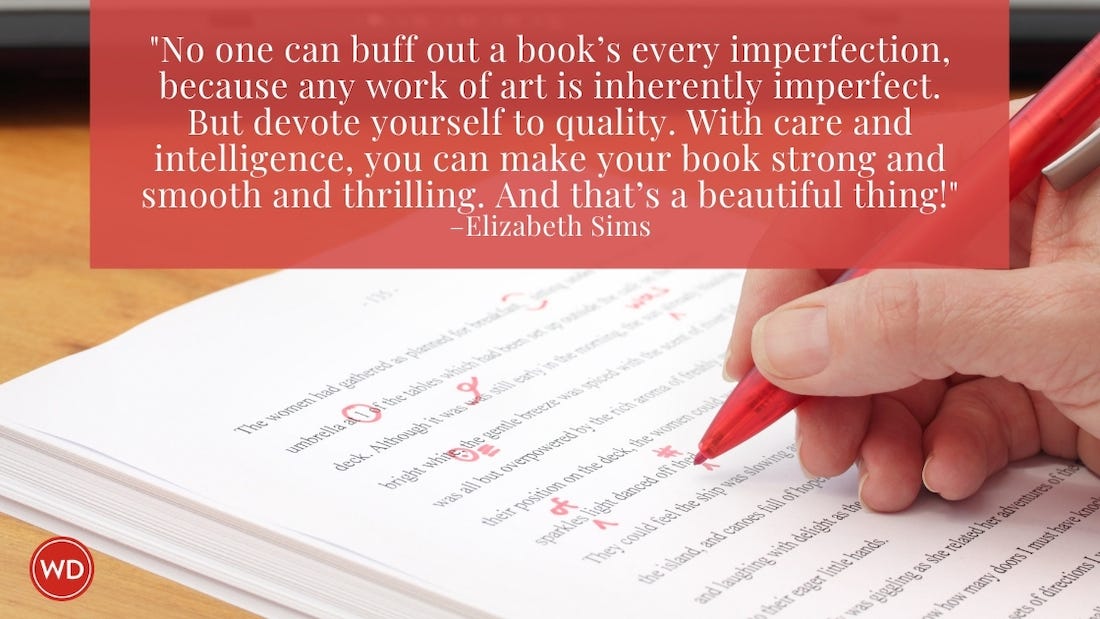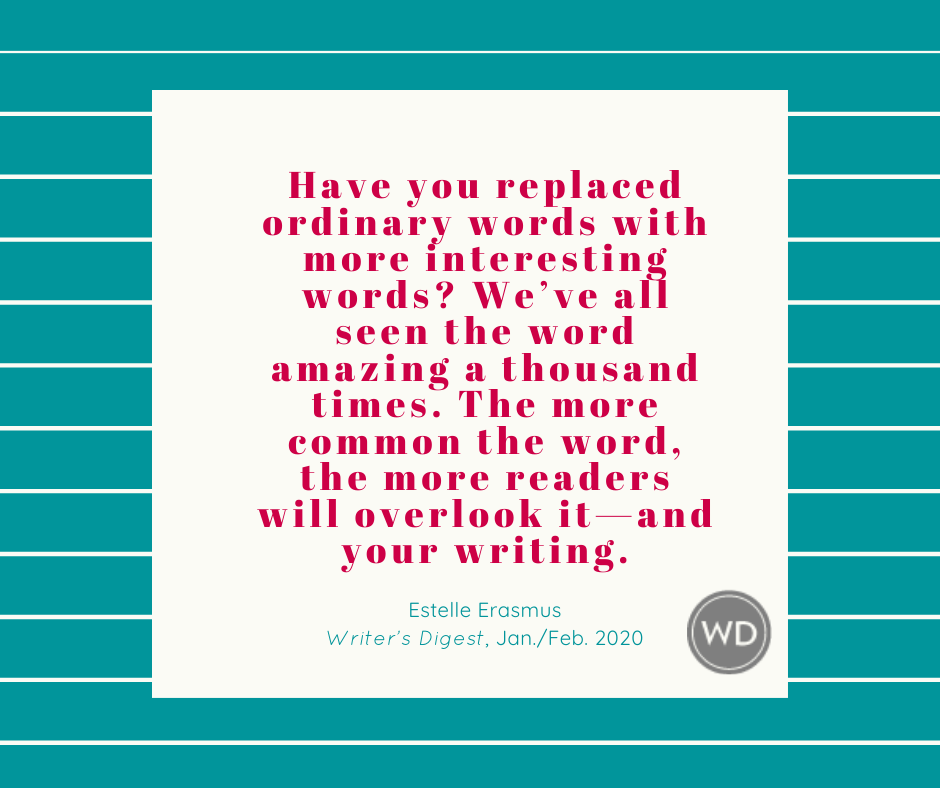Using Adjectives
In this excerpt from chapter two: Modifiers and Other Parts of Speech from The Writer’s Digest Grammar Desk Reference, you’ll learn: How to properly use adjectives. Learn how to avoid common grammatical errors.
Modifiers and Other Parts of Speech
Now that we have examined the building blocks of sentences—nouns and verbs—we can move on to the embellishments that either limit meaning or add further information (as well as direction, color, and detail to the basic grammatical unit).
Adjectives
An adjective modifies a noun or a pronoun by providing information that describes, clarifies, expands, or limits it. Most adjectives can appear before or after the word modified, and adjectives answer these questions: what kind? which one? how many? An adjective describes by contributing specific characteristics to a person, place, or thing in order to help the reader visualize or appreciate it.
In the following examples, the adjectives have been italicized and the nouns they are modifying have been boldfaced.
• Smith’s oblongpond
• a spindlyredwood
• his hideouslie
• the bloodshoteye
Notice that certain of the preceding adjectives were purely descriptive, whereas others added an element of subjective perception. Notice also that the italicized descriptive word was often accompanied by another modifier—an article (the, a), a pronoun (his, my), or the possessive form of a proper noun (Smith’s). All those words function as adjectives because they tell something about the noun they’re attached to. Below are words that modify nouns or pronouns, classified according to parts of speech.
Definite and Indefinite Articles
The definite article—the—points to only one particular example or instance of something: the dog, the answer, the spaghetti. An indefinite article—a or an—is more general because it points to any example of something: a dog, an answer (spaghetti can’t be preceded by an indefinite article because it is a noncount concrete noun). Articles are sometimes referred to as noun determiners because they signal that a noun is about to appear; they are also termed “limiting adjectives” because their presence before a noun eliminates the possibility that the noun could be misconstrued as something else: the dog means one specific dog, not another; a child means child, not monkey.
Pronouns
Many pronouns also function as adjectives because they tell something about the noun (or pronoun) they modify: my book, their house, your money. The preceding examples are of possessive pronouns, but other types of pronouns can also act as adjectives: demonstrative pronouns (this, these, that, those); indefinite pronouns (several, all, any, few, each, both, many, either, neither, some); interrogative pronouns (what, which, whose); and relative pronouns (who, which, that, whose, whatever, whichever). Words that function as cardinal or ordinal numbers are also adjectives: one, first, two, second, and so forth. The following sentences show how these pronouns (italicized), frequently referred to as limiting adjectives, modify the nouns to which they are attached.
• This car is fast.
• The first person in line will be admitted early.
• Many people prefer lasagna to macaroni.
• I am unsure which film you are referring to.
• Both dogs are sleeping on the porch.
An adjective can appear before or after the noun it modifies. In the typical sequence, an adjective appears before a noun: the full moon, an ordinary evening, this distressing event. However, an adjective can also appear post-position—that is, following the noun it modifies: the sky so blue, the man possessed, a land unexplored. Adjectives can also be compound or in series (see Chapter 18 for a full discussion of this topic).
Multiple adjectives modifying the same noun or pronoun are considered either coordinate or cumulative; if coordinate, each adjective could modify the noun separately, so commas are used, as in any series: The overripe, bursting, odiferous mangoes seeped onto the countertop. Notice that the arrangement of these adjectives has no particular order or rationale; each modifier might appear elsewhere in the series, and and could be placed between them: The bursting and odiferous and overripe mangoes seeped onto the countertop.
Cumulative adjectives, on the other hand, are not equivalent to a punctuated series because the first adjective in the group is not individually modifying the noun but is instead modifying the noun-modifier combination that follows. For example, in the phrase obsolete desktop computer, obsolete modifies desktop computer and desktop modifies computer. These adjectives cannot appear in a different order (the desktop obsolete computer), nor can they be connected with and (the desktop and obsolete computer).
Adjectives following the noun they modify can also be set off by commas, as in a typical noun-appositive pattern, here presented with compound adjectives: The children, muddy and shivering, finally came inside for hot chocolate. Notice that shivering is a present participle. Both past and present participles are very common modifiers.
In the sentences that follow, the past and present participles have been italicized.
• Crying and exhausted, the young child got out of bed.
• The howling dog broke my heart.
• Our skidding car bumped a stalled bus.
• The leaping, spinning clown amused our bored children.
Subjective and Objective Complements
Adjectives also appear as complements, either subjective or objective (see Chapter 1 for a discussion of complements). Complements are nouns sharing an identity with either the subject or the object, but complements can also be adjectives sharing that identity. In the following examples, the complements have been italicized.
• She is president.
In this sentence, the complement is a noun (a predicate nominative).
• She is wealthy.
In this sentence, the complement is a predicate adjective.
Predicate adjectives modify the noun subject, as the following sentences illustrate, often in conjunction with a greater variety of linking verbs than the forms of to be most often used with predicate nominatives. In the sentences below, the predicate adjectives have been italicized.
• The dog seems listless and ill.
• He felt abused, lost, and overwhelmed.
• The parrot finally grew quiet.
As objective complements, adjectives follow the direct or indirect object, just as nouns functioning as objective complements do. In each of the following pairs, the first sentence contains a noun objective complement, and the second, an adjective. The objective complements have been italicized.
• She called her boyfriend an idiot.
• She called her boyfriend idiotic.
• She thought the film a bore.
• She thought the film boring.
• She considered him an incompetent.
• She considered him.
Notice that in the last pair, an adjective is used as a noun: an incompetent. Similarly, other adjectives can function as nouns: the rich, the poor, the young, the restless, the beautiful, the smart, the disadvantaged, the good, the bad, the ugly.
Comparative and Superlative Adjectives
One of the most important characteristics of adjectives is that they express degree—comparative and superlative. For example, the sky may be blue, but it also may be bluer in Florida than in Ohio (according to someone’s perception), and it may be bluest of all in the Bahamas (again, according to a comparison of blue skies made by a particular viewer). All adjectives are capable of evolving from their original descriptive form to a more intense form of themselves, with the superlative indicating either the greatest degree or a comparison among more than two things.
Adjective Comparative Superlative
Thus you would say of two choices that one of them was better than the other, not best, and if you received bad news that was worse than other bad news, it would be the worst news of all. If parents have two children, and one behaves better than the other, then that child is the better behaved, not the best behaved. If three people were to present arguments for claiming the same prize, the strongest, clearest argument would prevail; but if only two people claimed the prize, then the stronger, clearer argument would win.
The general rule for creating the comparative and the superlative is to add -er or -est to the original modifier (pink, pinker, pinkest). However, there are exceptions and additional rules.
1. When the adjective ends in -y, drop the -y and add -ier or -iest (lovely, lovelier, loveliest).
2. When the adjective has three or more syllables, you generally add more or most to the original modifier: considerate, more considerate, most considerate.
3. Be aware of exceptions, as with two-syllable adjectives ending in -ful, -less, -ish, -able, -al, and -some, for example: more grateful/most grateful, more worthless/most worthless, more stylish/most stylish, more sinkable/most sinkable, more venal/most venal, more loathsome/most loathsome.
4. More and most should never be paired with an adjective that has a changed form in the comparative or superlative: more worse, more uglier, most friendliest, most cleanest.
In all cases of negative rather than positive comparison, less or fewer is comparative, and least or fewest is superlative.
• There are fewer cookies in this jar than there were yesterday.
• Nick is less sympathetic than his brother.
• My husband and I are least impressed with that particular candidate’s positions.
• In fact, he received the fewest votes of all.
Few in all its forms is used to modify only a plural (and therefore count) noun, whereas less in all its forms is used to modify noncount nouns: I have fewer pairs of shoes than you do. There is less sand on Fernandina Beach this year. The few apples remaining were rotten. Nick likes Bob least of all. In addition, less and its forms can be adjectives or adverbs, but few and its forms can only be adjectives.
Adjectives may appear in hyphenated form, as discussed thoroughly in Chapter 24. Whenever several adjectives combine to make a single-word modifier, that combination is hyphenated all the way to the last word constituting the modifier. The hyphenated modifiers in the examples below have been italicized.
• His over-the-top approach to sales is driving customers away.
• The spoiled child’s give-me-what-I-want-right-now attitude alienates other children.
• The Spanish-speaking population of Florida is quite large.
• His reaction to her ill-timed remark made everyone laugh.
• My well-developed, fast-paced argument won the debate.
About the Book
For more explanation and examples of proper (and improper) use of grammar, check out The Writer’s Digest Grammar Desk Reference by Gary Lutz and Diane Stevenson.









